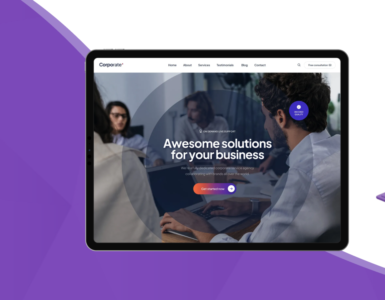Mobile application development has become indispensable for businesses aiming to enhance customer engagement and streamline operations. Whether you’re operating in a B2B or B2C environment, developing a custom mobile app is crucial. Among the various platforms available, iOS stands out due to its robust ecosystem and user base. This guide provides a comprehensive overview of the iOS app development process, updated with the latest trends and practices as of 2025.
- Comprehensive Market Research: Laying the Foundation
Before initiating the development process, it’s imperative to conduct thorough market research. This involves analyzing current trends in the iOS app market, understanding user preferences, and identifying gaps that your app could fill. By doing so, you can determine the essential features and functionalities that will make your app stand out.
Understanding your target audience is equally important. By identifying their needs and preferences, you can tailor your app to provide maximum value, ensuring higher user engagement and satisfaction.
- Ideation and Roadmapping: Defining the Vision
Once you’ve gathered sufficient market insights, the next step is to conceptualize your app. This involves defining the core purpose of the app, its primary features, and the problems it aims to solve. Creating a detailed roadmap will guide the development process, ensuring that all stakeholders are aligned with the project’s objectives.
Collaborating with an experienced iOS app development company can be beneficial at this stage. Their expertise can help refine your ideas and translate them into a feasible development plan.
- Wireframing: Visualizing the User Experience
Wireframing serves as the blueprint for your app, providing a visual representation of its layout and user flow. This step is crucial for identifying potential usability issues and making necessary adjustments before the actual development begins.
By creating detailed wireframes, you can ensure that the app’s navigation is intuitive and that all features are logically organized. This proactive approach minimizes the risk of costly revisions later in the development process.
- UI/UX Design: Crafting an Engaging Interface
The design phase focuses on creating an appealing and user-friendly interface. Adhering to Apple’s Human Interface Guidelines ensures that your app meets the platform’s standards for aesthetics and functionality.
In 2025, incorporating advanced design elements such as dynamic animations and adaptive layouts is essential. Utilizing tools like SwiftUI allows for the creation of responsive designs that provide a seamless experience across various iOS devices.

- Architecture Planning: Building a Scalable Framework
A well-structured architecture is vital for the app’s scalability and maintainability. This involves selecting appropriate design patterns, defining data models, and establishing a robust backend infrastructure.
Considering the integration of emerging technologies, such as AI and machine learning, can enhance your app’s capabilities. Planning for these integrations during the architectural phase ensures smoother implementation and better performance.
- Development: Bringing the App to Life
The development phase involves coding the app’s frontend and backend components. Swift remains the primary programming language for iOS development, offering safety and performance benefits.
Utilizing modern frameworks like SwiftUI streamlines the development process, allowing for real-time previews and simplified UI creation. Ensuring that the codebase is modular and well-documented facilitates easier updates and maintenance in the future.
- Testing: Ensuring Quality and Performance
Rigorous testing is essential to identify and rectify any issues before the app’s release. This includes functional testing, performance testing, and security assessments.
Automated testing tools can expedite the process, ensuring that the app performs optimally under various conditions. Additionally, beta testing with a select group of users provides valuable feedback for further refinement.
- App Store Submission: Navigating the Approval Process
Submitting your app to the App Store involves adhering to Apple’s guidelines and requirements. This includes providing detailed metadata, ensuring compliance with privacy policies, and preparing promotional materials.
Understanding the common reasons for app rejections can help you avoid pitfalls and expedite the approval process. Collaborating with professionals experienced in App Store submissions can further streamline this phase.
- Post-Launch Support: Maintaining and Enhancing the App
After the app’s release, ongoing support is crucial to address user feedback, fix bugs, and implement updates. Regularly monitoring app performance and user engagement metrics provides insights into areas for improvement.
Staying abreast of the latest iOS updates and incorporating new features ensures that your app remains relevant and competitive in the market.
Essential Tips for iOS App Development in 2025
- Define Clear Objectives: Establish the app’s goals and ensure that all features align with these objectives.
- Understand Your Audience: Tailor the app’s design and functionality to meet the specific needs of your target users.
- Prioritize User Experience: Focus on creating an intuitive and engaging interface that facilitates seamless navigation.
- Ensure Seamless Integration: If your business has an existing website, ensure that the app integrates smoothly, providing a consistent user experience across platforms.
- Stay Updated with Trends: Incorporate the latest technologies and design trends to enhance the app’s appeal and functionality.
Developing a successful iOS app in 2025 requires a strategic approach, combining thorough planning, innovative design, and robust development practices. By following this comprehensive guide, you can create an app that not only meets user expectations but also stands out in the competitive App Store landscape.
For more insights on iOS app development, explore our detailed articles on native iOS vs hybrid app development and iOS app development services
For official guidelines and resources, refer to Apple’s App Store Review Guidelines.
























